A team of scientists led by young Croatian evolutionary geneticist Tomislav Domazet-Lošo from Ruder Boškovic Institute (RBI) in Zagreb, Croatia, developed a novel methodological approach in evolutionary studies.
Using the method they named 'genomic phylostratigraphy', its authors shed new and unexpected light on some of the long standing macroevolutionary issues, which have been puzzling evolutionary biologists since Darwin.
The only direct method of research in evolutionary history involves analyzing the fossil remains of once living organisms, excavated in various localities throughout of the world. However, that approach often cannot provide the full evolutionary pathway of some species, as it requires uncovering of many fossils from various stages of its evolutionary history. As the fossil record is imperfect, the evolution research fundamentally hinges on luck factor in discovering the adequate paleontological sites.

However, the RBI team proposed a novel and interesting approach to bypass this obstacle. Namely, they suggested that the genome of every extant species carries the ‘snapshots’ of evolutionary epochs that species went trough. What's even more important, they also developed the method which enables evolution researchers to readily convert those individual 'snapshots’ into the full-length 'evolutionary movie' of a species.
Applying their new methodology on the fruit fly genomic data they tackled some of the most intriguing evolutionary puzzles - some of which distressed even Darwin himself. First, they demonstrated that parts of the living organism exposed to the environment – so called ‘ectoderm’ - are more prone to evolutionary changes. Further, they explained the evolutionary origin of the ‘germ layers’, the primary tissue forms that form during the first days after the conception of a new animal, and from which subsequently all other tissues are developed. Finally, they discovered the potential genetic trigger for the 'Cambrian explosion', a major global evolutionary event on the planet, when some 540 million years ago almost all animal forms known today suddenly 'appeared'.
The first public lecture on these findings will be given by dr. Domazet-Lošo on September 4th at 5. ISABS Conference in Forensic Genetics and Molecular Anthropology, held in Split, Croatia.
Source: Rudjer Boskovic Institute




Comments